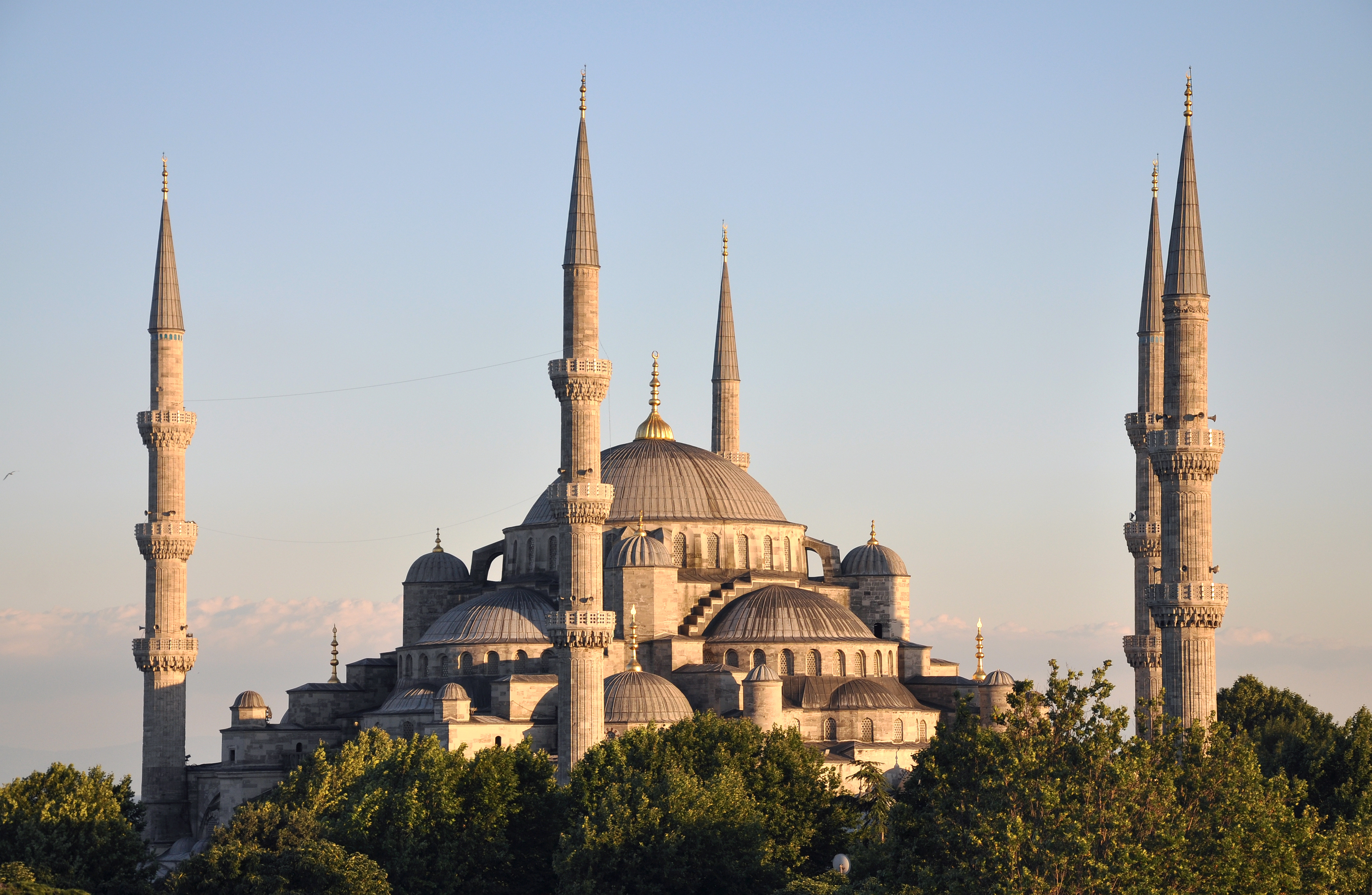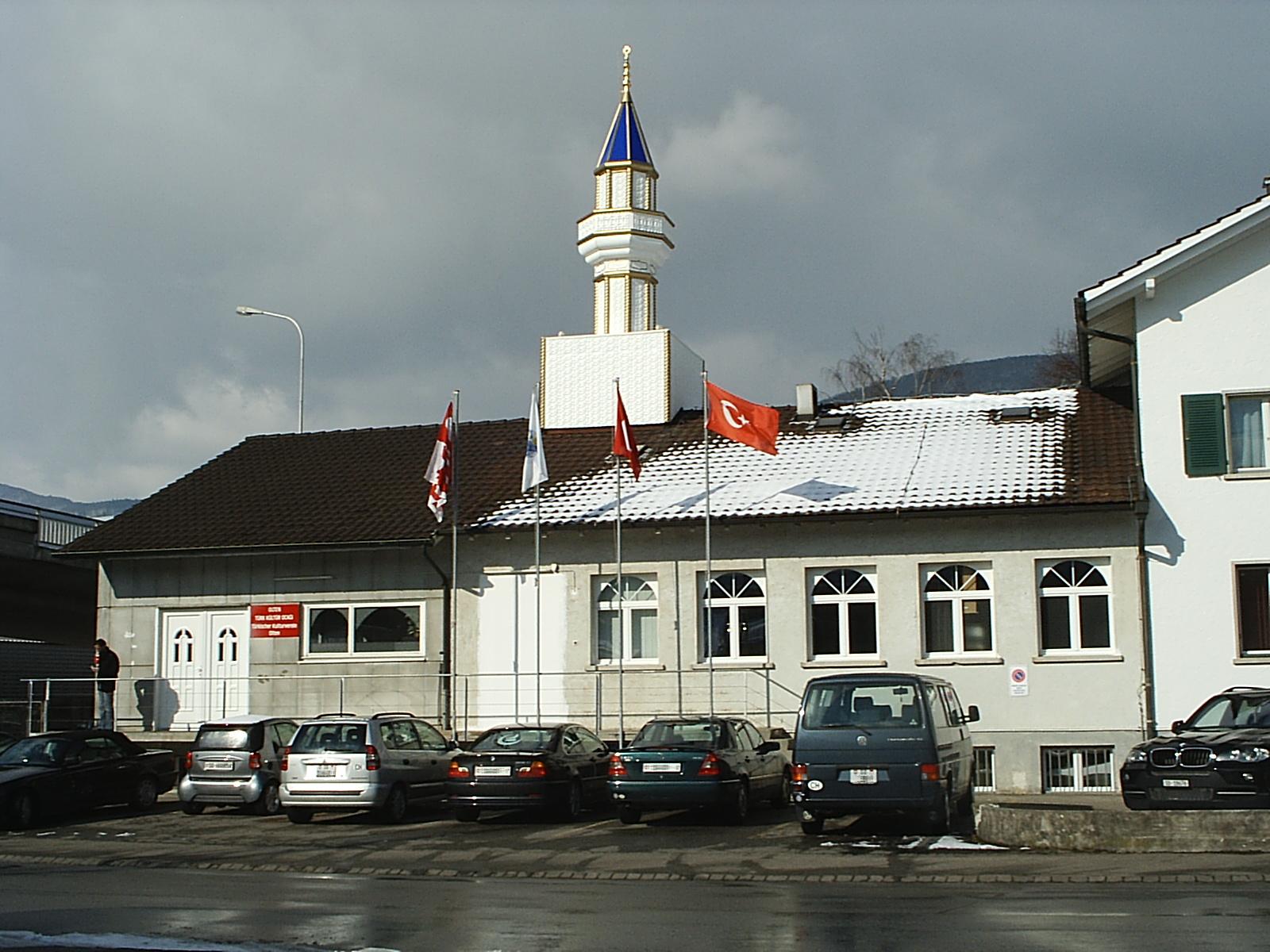|
Mahmood Mosque (Zurich)
The Mahmood Mosque, () situated in Forchstrasse, Zurich, is the first purpose-built mosque in Switzerland. It is owned and run by the Ahmadiyya Muslim Community. The mosque has a minaret, the new construction of which is now banned in Switzerland by popular vote. The foundation stone was laid with a stone from the wall of the Mubarak Mosque, Qadian, Mubarak Mosque, India by Amatul Hafeez Begum, daughter of the founder of the Ahmadiyya, Ahmadiyya Muslim Community, Mirza Ghulam Ahmad on August 25, 1962. It was a sign of the emancipation of Muslim women, both then and now. The mosque was inaugurated on June 22, 1963, by the then President of the 17th session of the United Nations General Assembly, Sir Muhammad Zafarullah Khan, in the presence of the Mayor of Zurich, Dr. :de:Emil Landolt, Emil Landolt. The mission in Switzerland was led by Mushtaq Ahmad Bajwa from June 1962 until January 1975. History In the post-war period, Islam came to Switzerland through the Ahmadiyya, Ahmadiyy ... [...More Info...] [...Related Items...] OR: [Wikipedia] [Google] [Baidu] |
Ahmadiyya
Ahmadiyya (, ), officially the Ahmadiyya Muslim Community or the Ahmadiyya Muslim Jama'at (AMJ, ar, الجماعة الإسلامية الأحمدية, al-Jamāʿah al-Islāmīyah al-Aḥmadīyah; ur, , translit=Jamā'at Aḥmadiyyah Muslimah), is an Islamic revival or messianic movement originating in Punjab, British India, in the late 19th century. It was founded by Mirza Ghulam Ahmad (1835–1908), who claimed to have been divinely appointed as both the Promised Mahdi (Guided One) and Messiah expected by Muslims to appear towards the end times and bring about, by peaceful means, the final triumph of Islam; as well as to embody, in this capacity, the expected eschatological figure of other major religious traditions. Adherents of the Ahmadiyya—a term adopted expressly in reference to Muhammad's alternative name '' Aḥmad''—are known as Ahmadi Muslims or simply Ahmadis. Ahmadi thought emphasizes the belief that Islam is the final dispensation for humanity as r ... [...More Info...] [...Related Items...] OR: [Wikipedia] [Google] [Baidu] |
Muhammad Zafarullah Khan
Chaudhry Sir Muhammad Zafarullah Khan ( ur, ; 6 February 1893 – 1 September 1985) was a Pakistani jurist and diplomat who served as the first Foreign Minister of Pakistan. After serving as foreign minister he continued his international career and is the only Pakistani to preside over the International Court of Justice. He also served as the President of the UN General Assembly. He is the only person to date to serve as the President of both UN General Assembly and the International Court of Justice. Khan became one of the most vocal proponents of Pakistan and led the case for the separate nation in the Radcliffe Commission which drew the countries of modern-day South Asia. He moved to Karachi in August 1947 and became a member of Pakistan's first cabinet serving as the country's debut foreign minister under the Liaquat administration. He remained Pakistan's top diplomat until 1954 when he left to serve on the International Court of Justice and remained on the court ... [...More Info...] [...Related Items...] OR: [Wikipedia] [Google] [Baidu] |
Mosques Completed In 1963
A mosque (; from ar, مَسْجِد, masjid, ; literally "place of ritual prostration"), also called masjid, is a place of prayer for Muslims. Mosques are usually covered buildings, but can be any place where prayers (sujud) are performed, including outdoor courtyards. The first mosques were simple places of prayer for Muslims, and may have been open spaces rather than buildings. In the first stage of Islamic architecture, 650-750 CE, early mosques comprised open and closed covered spaces enclosed by walls, often with minarets from which calls to prayer were issued. Mosque buildings typically contain an ornamental niche (''mihrab'') set into the wall that indicates the direction of Mecca ('' qiblah''), ablution facilities. The pulpit (''minbar''), from which the Friday ( jumu'ah) sermon ('' khutba'') is delivered, was in earlier times characteristic of the central city mosque, but has since become common in smaller mosques. Mosques typically have segregated spaces for me ... [...More Info...] [...Related Items...] OR: [Wikipedia] [Google] [Baidu] |
Buildings And Structures In Zurich
A building, or edifice, is an enclosed structure with a roof and walls standing more or less permanently in one place, such as a house or factory (although there's also portable buildings). Buildings come in a variety of sizes, shapes, and functions, and have been adapted throughout history for a wide number of factors, from building materials available, to weather conditions, land prices, ground conditions, specific uses, prestige, and aesthetic reasons. To better understand the term ''building'' compare the list of nonbuilding structures. Buildings serve several societal needs – primarily as shelter from weather, security, living space, privacy, to store belongings, and to comfortably live and work. A building as a shelter represents a physical division of the human habitat (a place of comfort and safety) and the ''outside'' (a place that at times may be harsh and harmful). Ever since the first cave paintings, buildings have also become objects or canvasses of much artistic ... [...More Info...] [...Related Items...] OR: [Wikipedia] [Google] [Baidu] |
Ahmadiyya Mosques In Switzerland
Ahmadiyya (, ), officially the Ahmadiyya Muslim Community or the Ahmadiyya Muslim Jama'at (AMJ, ar, الجماعة الإسلامية الأحمدية, al-Jamāʿah al-Islāmīyah al-Aḥmadīyah; ur, , translit=Jamā'at Aḥmadiyyah Muslimah), is an Islamic revival or messianic movement originating in Punjab, British India, in the late 19th century. It was founded by Mirza Ghulam Ahmad (1835–1908), who claimed to have been divinely appointed as both the Promised Mahdi (Guided One) and Messiah expected by Muslims to appear towards the end times and bring about, by peaceful means, the final triumph of Islam; as well as to embody, in this capacity, the expected eschatological figure of other major religious traditions. Adherents of the Ahmadiyya—a term adopted expressly in reference to Muhammad's alternative name ''Aḥmad''—are known as Ahmadi Muslims or simply Ahmadis. Ahmadi thought emphasizes the belief that Islam is the final dispensation for humanity as reveale ... [...More Info...] [...Related Items...] OR: [Wikipedia] [Google] [Baidu] |
List Of Mosques In Europe ...
This is a partial list of mosques in Europe. ;Group See also * Lists of mosques * Islam in Europe References External links * * mapof mosques in Europe {{DEFAULTSORT:List Of Mosques In Europe * !Europe Mosques A mosque (; from ar, مَسْجِد, masjid, ; literally "place of ritual prostration"), also called masjid, is a place of prayer for Muslims. Mosques are usually covered buildings, but can be any place where prayers ( sujud) are performed, i ... [...More Info...] [...Related Items...] OR: [Wikipedia] [Google] [Baidu] |
Islam In Switzerland
Islam in Switzerland has mostly arrived via immigration since the late 20th century. Numbering below 1% of total population in 1980, the fraction of Muslims in the population of permanent residents in Switzerland has quintupled in thirty years, estimated at just above 5% as of 2013. A majority is from Former Yugoslavia (estimated at 56% as of 2010, most of them from Kosovo); an additional 20% (2010 estimate) is from Turkey. This is due to the fact that in the 1960s and 1970s Switzerland encouraged young men from Yugoslavia and Turkey to come as guest workers. Initially these young men were only planning on staying in Switzerland temporarily, however, revised Swiss immigration laws in the 1970s permitted family regrouping. Consequently, these men ended up staying in Switzerland as these new laws allowed the wives and children of these young men into the country. Since this time period, most of the Muslim immigration to Switzerland stems from asylum seekers arriving primarily from ... [...More Info...] [...Related Items...] OR: [Wikipedia] [Google] [Baidu] |
United Nations General Assembly
The United Nations General Assembly (UNGA or GA; french: link=no, Assemblée générale, AG) is one of the six principal organs of the United Nations (UN), serving as the main deliberative, policymaking, and representative organ of the UN. Currently in its 77th session, its powers, composition, functions, and procedures are set out in Chapter IV of the United Nations Charter. The UNGA is responsible for the UN budget, appointing the non-permanent members to the Security Council, appointing the UN secretary-general, receiving reports from other parts of the UN system, and making recommendations through resolutions. It also establishes numerous subsidiary organs to advance or assist in its broad mandate. The UNGA is the only UN organ wherein all member states have equal representation. The General Assembly meets under its president or the UN secretary-general in annual sessions at the General Assembly Building, within the UN headquarters in New York City. The main part o ... [...More Info...] [...Related Items...] OR: [Wikipedia] [Google] [Baidu] |
Zurich
Zurich (; ) is the largest city in Switzerland and the capital of the canton of Zurich. It is located in north-central Switzerland, at the northwestern tip of Lake Zurich. , the municipality had 443,037 inhabitants, the urban area 1.315 million (2009), and the Zurich metropolitan area 1.83 million (2011). Zurich is a hub for railways, roads, and air traffic. Both Zurich Airport and Zurich's main railway station are the largest and busiest in the country. Permanently settled for over 2,000 years, Zurich was founded by the Romans, who called it '. However, early settlements have been found dating back more than 6,400 years (although this only indicates human presence in the area and not the presence of a town that early). During the Middle Ages, Zurich gained the independent and privileged status of imperial immediacy and, in 1519, became a primary centre of the Protestant Reformation in Europe under the leadership of Huldrych Zwingli. The official language of Zurich is Germ ... [...More Info...] [...Related Items...] OR: [Wikipedia] [Google] [Baidu] |
Mirza Ghulam Ahmad
Mirzā Ghulām Ahmad (13 February 1835 – 26 May 1908) was an Indian religious leader and the founder of the Ahmadiyya movement in Islam. He claimed to have been divinely appointed as the promised Messiah and Mahdi—which is the metaphorical second-coming of Jesus (''mathīl-iʿIsā''), in fulfillment of Islam's latter day prophecies, as well as the Mujaddid (centennial reviver) of the 14th Islamic century."The Fourteenth-Century's Reformer / Mujaddid", from the "Call of Islam", by Maulana Muhammad Ali Born to a family with aristocratic roots in Qadian, rural Punjab, Ghulam Ahmad emerged as a writer and debater for Islam. When he was just over forty years of age, his father died and around that time he believed that God began to communicate with him. In 1889, he took a pledge of allegiance from forty of his supporters at Ludhiana and formed a community of followers upon what he claimed was divine instruction, stipulating ten conditions of initiation, an event that ma ... [...More Info...] [...Related Items...] OR: [Wikipedia] [Google] [Baidu] |
Mubarak Mosque, Qadian
The Mubarak Mosque or Masjid Mubarak is a mosque in Qadian and the first Ahmadiyya mosque. It was opened in 1883 by Mirza Ghulam Ahmad, the founder of the Ahmadiyya Movement. Style The entrance to the mosque has the following inscription: مُبَارِكٌ وَّ مُبَارَكٌ وَّ كُلُّ اَمْرٍ مُّبَارَكٍ يُّجْعَلُ فِيْهِ ''“This mosque is a source of blessings, is blessed itself, and every blessed deed will be performed in it.”'' See also * Islam in India Islam is India's India#Demographics, languages, and religion, second-largest religion, with 14.2% of the country's population, approximately 172.2 million people identifying as adherents of Islam in 2011 Census. India is also the country with ... References External links Photos on the alislam.org mosque gallery Ahmadiyya mosques in India Mosques in Punjab, India {{India-mosque-stub ... [...More Info...] [...Related Items...] OR: [Wikipedia] [Google] [Baidu] |









